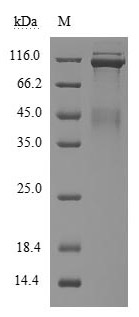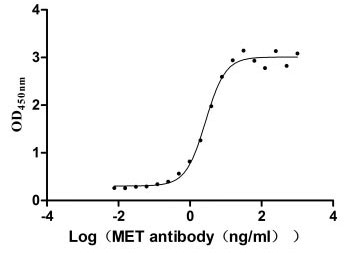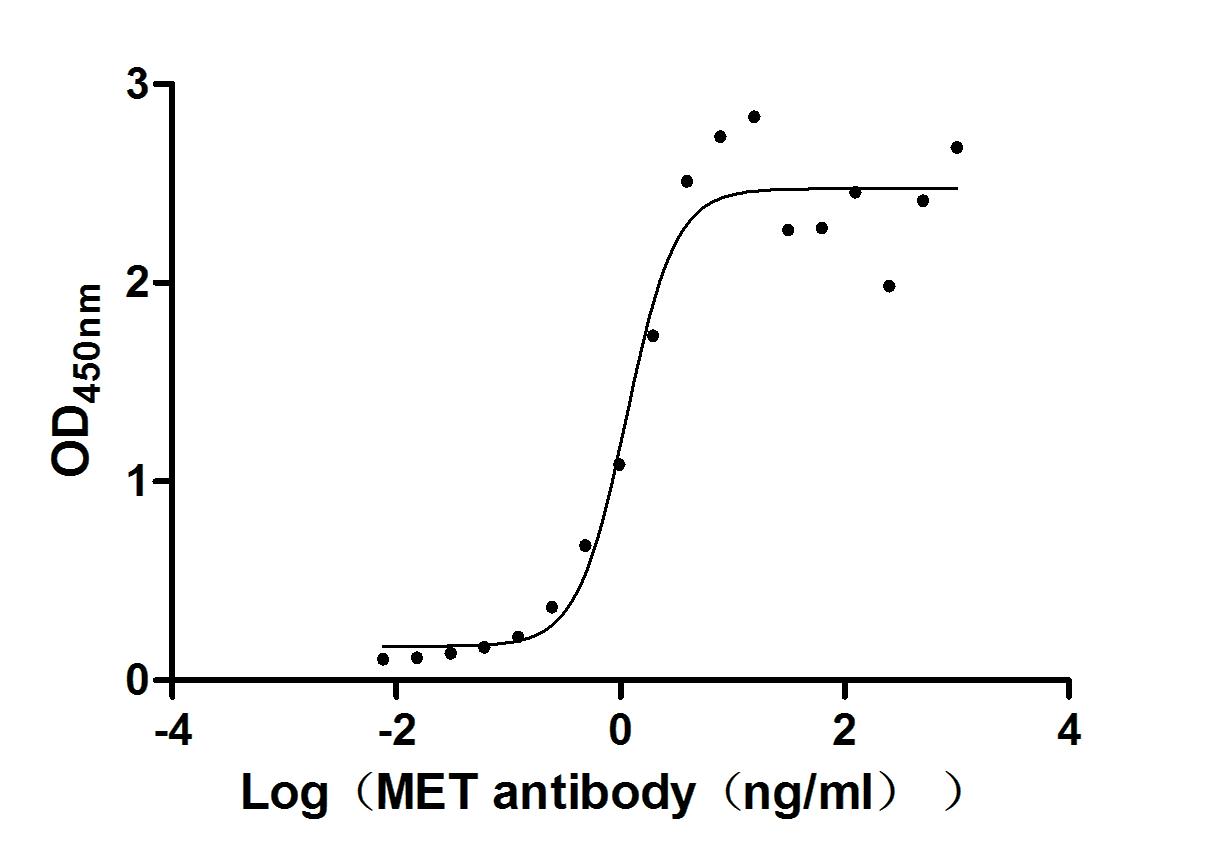The recombinant human MET is a high-purity protein with endotoxin levels below 1.0 EU/μg, as determined by the LAL method. Its purity is over 90% as measured by SDS-PAGE. It is expressed with the plasmid that contains the gene fragment encoding the 25-932aa of human MET and the C-terminal hFc-tag gene in mammalian cells. The recombinant MET protein's activity has been validated via functional ELISA, showing a binding EC50 of 2.379-3.094 ng/ml with an anti-MET recombinant antibody.
The human HGFR, also called c-Met/MET, is a receptor tyrosine kinase that plays a critical role in various physiological processes, including cell growth, motility, and differentiation. Upon binding of HGF, c-Met undergoes dimerization, which activates its intrinsic tyrosine kinase activity, leading to autophosphorylation and the recruitment of downstream signaling molecules [1][2]. This activation cascade is essential for mediating various cellular responses, including DNA synthesis, cell migration, and tissue regeneration [3][4].
The HGF/c-Met signaling pathway is also important for pathological conditions, particularly in cancer progression and metastasis. Aberrant activation of the c-Met pathway has been implicated in several malignancies, contributing to tumor growth, invasion, and metastasis [5-7]. Additionally, mutations in the MET gene have been associated with various diseases, including nonsyndromic hearing loss, underscoring the receptor's diverse biological roles [8].
References:
[1] C. Basilico, A. Arnesano, M. Galluzzo, P. Comoglio, & P. Michieli, A high-affinity hepatocyte growth factor-binding site in the immunoglobulin-like region of met, Journal of Biological Chemistry, vol. 283, no. 30, p. 21267-21277, 2008. https://doi.org/10.1074/jbc.m800727200
[2] J. Rubin, R. Day, D. Breckenridge, N. Atabey, W. Taylor, S. Stahlet al., Dissociation of heparan sulfate and receptor binding domains of hepatocyte growth factor reveals that heparan sulfate-c-met interaction facilitates signaling, Journal of Biological Chemistry, vol. 276, no. 35, p. 32977-32983, 2001. https://doi.org/10.1074/jbc.m105486200
[3] S. Paranjpe, W. Bowen, A. Bell, K. Nejak‐Bowen, J. Luo, & G. Michalopoulos, Cell cycle effects resulting from inhibition of hepatocyte growth factor and its receptor c-met in regenerating rat livers by rna interference, Hepatology, vol. 45, no. 6, p. 1471-1477, 2007. https://doi.org/10.1002/hep.21570
[4] T. Kato, Biological roles of hepatocyte growth factor‑met signaling from genetically modified animals (review), Biomedical Reports, 2017. https://doi.org/10.3892/br.2017.1001
[5] S. Aguirre, J. Heyen, W. Collette, W. Bobrowski, & E. Blasi, Cardiovascular effects in rats following exposure to a receptor tyrosine kinase inhibitor, Toxicologic Pathology, vol. 38, no. 3, p. 416-428, 2010. https://doi.org/10.1177/0192623310364027
[6] T. Takayanagi, Y. Aoki, & K. Tanaka, Expression of constitutively active c-met receptor in human choriocarcinoma, Gynecologic and Obstetric Investigation, vol. 50, no. 3, p. 198-202, 2000. https://doi.org/10.1159/000010310
[7] F. Shojaei, J. Lee, B. Simmons, A. Wong, C. Esparza, P. Plumleeet al., Hgf/c-met acts as an alternative angiogenic pathway in sunitinib-resistant tumors, Cancer Research, vol. 70, no. 24, p. 10090-10100, 2010. https://doi.org/10.1158/0008-5472.can-10-0489
[8] G. Mujtaba, J. Schultz, A. Imtiaz, R. Morell, T. Friedman, & S. Naz, A mutation ofmet, encoding hepatocyte growth factor receptor, is associated with humandfnb97hearing loss, Journal of Medical Genetics, vol. 52, no. 8, p. 548-552, 2015. https://doi.org/10.1136/jmedgenet-2015-103023






